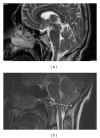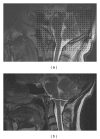Analysis of the volumes of the posterior cranial fossa, cerebellum, and herniated tonsils using the stereological methods in patients with Chiari type I malformation
- PMID: 22629166
- PMCID: PMC3354683
- DOI: 10.1100/2012/616934
Analysis of the volumes of the posterior cranial fossa, cerebellum, and herniated tonsils using the stereological methods in patients with Chiari type I malformation
Abstract
Objective: The aim of this study was to determine the posterior cranial fossa volume, cerebellar volume, and herniated tonsillar volume in patients with chiari type I malformation and control subjects using stereological methods.
Material and methods: These volumes were estimated retrospectively using the Cavalieri principle as a point-counting technique. We used magnetic resonance images taken from 25 control subjects and 30 patients with chiari type I malformation.
Results: The posterior cranial fossa volume in patients with chiari type I malformation was significantly smaller than the volume in the control subjects (P < 0.05). In the chiari type I malformation group, the cerebellar volume was smaller than the control group, but this difference was not statistically significant (P > 0.05). In the chiari type I malformation group, the ratio of cerebellar volume to posterior cranial fossa volume was higher than in the control group. We also found a positive correlation between the posterior cranial fossa volume and cerebellar volume for each of the groups (r = 0.865, P < 0.001). The mean (±SD) herniated tonsillar volume and length were 0.89 ± 0.50 cm(3) and 9.63 ± 3.37 mm in the chiari type I malformation group, respectively. Conclusion. This study has shown that posterior cranial fossa and cerebellum volumes can be measured by stereological methods, and the ratio of these measurements can contribute to the evaluation of chiari type I malformation cases.
Figures



Similar articles
-
Demographic confounders in volumetric MRI analysis: is the posterior fossa really small in the adult Chiari 1 malformation?AJR Am J Roentgenol. 2015 Apr;204(4):835-41. doi: 10.2214/AJR.14.13384. AJR Am J Roentgenol. 2015. PMID: 25794074
-
Two distinct populations of Chiari I malformation based on presence or absence of posterior fossa crowdedness on magnetic resonance imaging.J Neurosurg. 2017 Jun;126(6):1934-1940. doi: 10.3171/2016.6.JNS152998. Epub 2016 Sep 2. J Neurosurg. 2017. PMID: 27588590
-
Pathogenesis of Chiari malformation: a morphometric study of the posterior cranial fossa.J Neurosurg. 1997 Jan;86(1):40-7. doi: 10.3171/jns.1997.86.1.0040. J Neurosurg. 1997. PMID: 8988080 Clinical Trial.
-
Rapid development of Chiari I malformation in an infant with Seckel syndrome and craniosynostosis. Case report and review of the literature.J Neurosurg. 2003 May;98(5):1113-5. doi: 10.3171/jns.2003.98.5.1113. J Neurosurg. 2003. PMID: 12744374 Review.
-
Posterior Fossa Dimensions of Chiari Malformation Patients Compared with Normal Subjects: Systematic Review and Meta-Analysis.World Neurosurg. 2020 Jun;138:521-529.e2. doi: 10.1016/j.wneu.2020.02.182. Epub 2020 Mar 7. World Neurosurg. 2020. PMID: 32156591
Cited by
-
Volumetric segmentation in the context of posterior fossa-related pathologies: a systematic review.Neurosurg Rev. 2024 Apr 19;47(1):170. doi: 10.1007/s10143-024-02366-4. Neurosurg Rev. 2024. PMID: 38637466 Free PMC article.
-
The posterior cranial fossa: a comparative MRI-based anatomic study of linear dimensions and volumetry in a homogeneous South Indian population.Surg Radiol Anat. 2015 Oct;37(8):901-12. doi: 10.1007/s00276-015-1434-7. Epub 2015 Jan 28. Surg Radiol Anat. 2015. PMID: 25626883
-
Geometric morphometric analysis of the brainstem and cerebellum in Chiari I malformation.Front Neuroanat. 2024 Aug 7;18:1434017. doi: 10.3389/fnana.2024.1434017. eCollection 2024. Front Neuroanat. 2024. PMID: 39170851 Free PMC article.
-
Supratentorial cerebrospinal fluid diversion using image-guided trigonal ventriculostomy during retrosigmoid craniotomy for cerebellopontine angle tumors.Front Surg. 2023 May 23;10:1198837. doi: 10.3389/fsurg.2023.1198837. eCollection 2023. Front Surg. 2023. PMID: 37288135 Free PMC article.
-
Neuroimaging and the clinical manifestations of Chiari Malformation Type I (CMI).Curr Pain Headache Rep. 2015 Jun;19(6):18. doi: 10.1007/s11916-015-0491-2. Curr Pain Headache Rep. 2015. PMID: 26017710 Review.
References
-
- Meadows J, Kraut M, Guarnieri M, Haroun RI, Carson BS. Asymptomatic Chiari Type I malformations identified on magnetic resonance imaging. Journal of Neurosurgery. 2000;92(6):920–926. - PubMed
-
- Ramachandran R, Praharaj MS, Jayakumar PN. Chiari 1 malformations: an Indian hospital experience. Singapore Medical Journal. 2008;49(12):1029–1034. - PubMed
-
- Ishikawa M, Kikuchi H, Fujisawa I, Yonekawa Y. Tonsillar herniation on magnetic resonance imaging. Neurosurgery. 1988;22(1 I):77–81. - PubMed
-
- Atkinson JLD, Kokmen E, Miller GM. Evidence of posterior fossa hypoplasia in the familial variant of adult Chiari I malformation: case report. Neurosurgery. 1998;42(2):401–404. - PubMed
MeSH terms
LinkOut - more resources
Full Text Sources
Medical

